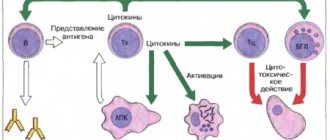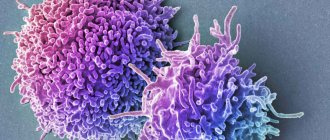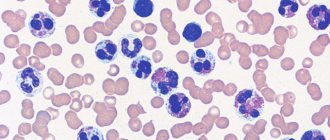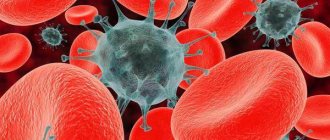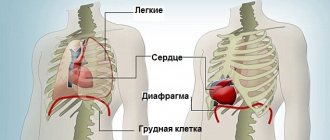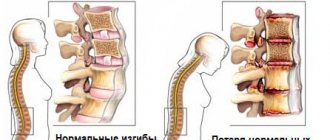Functions
Basic functions of lymphocytes
The main functions of lymphocytes include:
- Antibody synthesis,
- Recognition of foreign agents and their subsequent destruction,
- Elimination of own cells that are defective or mutants,
- Implementation of immune memory - cells remember a number of agents and do not allow them to develop. Vaccinations are based on this principle.
Lymphocytes contribute to transplant rejection, which does not play the best role in the body. Another function that does not always help a person is increasing sensitivity to foreign agents.
What are lymphocytes responsible for?
There are several types of white cells.
Each type performs specific functions that regulate the functioning of the immune system. All bodies are divided into:
- T-lymphocytes are white cells that provide cellular immunity,
- B lymphocytes are cells that contribute to humoral immunity. They recognize foreign agents and produce antibodies to them,
- Null lymphocytes are cells that can become T or B lymphocytes. Subsequently, they become natural killers. HK lymphocytes are capable of destroying the membrane of foreign proteins.
Kinds
T lymphocytes are divided into three types:
- Killer T-cells destroy foreign cells (they can be infected by viruses or cancer cells). HK lymphocytes differ from killer T cells in that they do not develop immunity to foreign agents,
- T-helper cells - this type of lymphocyte helps produce antibodies to quickly suppress the disease,
- T suppressors are white cells that reduce the production of antibodies. They start working when there is no longer a threat to the body.
Types of lymphocytes
Formed in the bone marrow, T-lymphocytes are sent to the thymus, are there for training, and, if necessary, carry out cellular immunity . B lymphocytes are sent to the lymph nodes, where they turn into mature and full-fledged cells.
The formation of these cells in the body
Lymphocytes are the smallest white blood cells that perform an immune function in the blood.
Lymphocytes in the blood destroy the body's own damaged cells of different types. Their shape is close to round.
A significant part of the volume of a leukocyte of this type is occupied by a formed round or slightly elongated nucleus.
If the human body is attacked by harmful bacteria, the formation of atypical or reactive lymphocytes occurs in the blood.
Such cells may differ from ordinary ones in their shapes and sizes. Their core often does not have a clearly defined shape, the boundaries are blurred or have peculiar jagged edges.
The appearance of atypical cells is due to the fact that the body seeks to ensure cellular diversity in order to increase the protective functions of the immune system.
Among cells of different configurations, it is more likely that the same type will be found that will be able to more effectively destroy a specific infection that has affected the body.
This is why atypical white blood cells of different configurations can form due to severe infections.
All blood cells are formed in the red bone marrow from stem cells. Since lymphocytes are capable of destroying the body's own tissues if they recognize pathology in them, there are mechanisms in the bone marrow that inhibit the activity of these cells.
The maturation of lymphocytes and their activation occurs after these leukocytes leave the bone marrow. Thus, they do not harm stem cells important for hematopoiesis.
The process of maturation of lymphocytes and the growth of their active immune activity occurs in the thymus gland or thymus.
In this organ, leukocytes of this type begin to secrete specific enzymes that stimulate the development of immunity.
The thymus is located in the upper part of the chest at the base of the sternum. This organ is responsible for the formation of human immunity.
The thymus performs its functions most actively in young children, so their level of lymphocytes is much higher than in adults.
With age, there is a natural decrease in the size of the thymus until it completely disappears.
Some lymphocytes complete their maturation in the spleen. This organ produces antibodies to resist specific infections.
In addition, the spleen produces specific hormones that regulate the activity of the bone marrow and affect the production of cells of one type or another.
READ What causes elevated lymphocytes in the blood of women?
Video:
Lymph nodes are a kind of storage of lymphocytes in the body. If a certain organ is affected by infection, the lymph nodes increase in size.
Inflammation of several lymph nodes of different locations may indicate immune disorders of the body. Most often, nodes in the throat and tonsils are susceptible to inflammation.
Lymphocyte counts in adults
In men and women, the number of lymphocytes in the normal state does not differ.
If a woman is pregnant or donates blood during the menstrual cycle, the number of lymphocytes will be higher than normal.
This is not something to be afraid of. The body reacts to hormonal imbalances in the female body.
Norm for women by age (table)
Age; Norm of lymphocytes; Specific gravity in the leukocyte formula; Lymphocytes during pregnancy; Normal for menstruation
| Over 18 years old | 1 – 4.8 * 10 9 cells per liter of blood | 19 – 37 % | 18 – 44%, but the figure can reach up to 50% | 18 – 50 % |
During pregnancy, the immune system decreases, since the fetus carries 50% of foreign information, and with strong immunity, the child will be rejected by the body. Sometimes lymphocytes during pregnancy are slightly lower than normal.
When the specific gravity of lymphocytes increases by more than 15% (during pregnancy and menstruation), doctors prescribe additional tests, since the risk of developing diseases is high.
In case of blood flow disturbances, regular inflammation of the lymph nodes, or pathologies of the development of the lymphatic system, doctors prescribe lymphography (also known as lymphogram). The procedure allows you to assess the condition of each type of lymph cell.
Functional tasks of lymphocytes
The main task of lymphocytes is to protect against infectious diseases and degenerated cells and normalize the functioning of the immune system.
White blood cells of the lymphocytic group destroy fungi, viruses, pathogenic bacteria and cancer.
A change in the number of lymphocytes (increase or decrease), identified by the leukocyte formula, allows a patient to be diagnosed.
Leukocytes perform several important functions:
- carry out the destruction of agents foreign to the body;
- identify aggressors with scout cells;
- recognize healthy tissue cells;
- form an immune barrier that resists infections;
- destroy mutated cells;
- record information about aggressive elements and transmit it to subsequent generations of cells;
- prevent the penetration of pathogenic microorganisms into the internal environment of the body through damage to the skin.
Each age group of people has its own norm of lymphocyte content. The largest number of purely lymphocytic cells in infants is 45–70%.
In children from two to ten years old - 30 - 50%. In adults, lymphocytes are contained in a volume of 19–37%. For adult women and men, the norm of lymphocyte cells is the same.
But during pregnancy and menstruation in women, lymphocytes can increase up to 50%. This increase is not considered pathological.
Video:
Poor diet, improperly organized eating habits (vegetarianism, eating only raw foods, long-term starvation diets or eating low-calorie foods without medical indications) can lead to a change in the normal content of the number of lymphocytes.
Prolonged nervous overstrain, repeated stressful situations, a polluted environment and bad habits - smoking, alcohol abuse - also leave an unfavorable imprint on general health and change the leukocyte formula.
READ When do activated lymphocytes appear?
All about lymphocytes in children
In childhood, the range of lymphocytes is very wide.
It makes up from 30 to 70% of the entire leukocyte formula. The fact is that the child is just developing his own immunity, and the baby’s body is getting acquainted with the surrounding reality. Age; Norm of lymphocytes; Specific gravity in the leukocyte formula
| From birth to 1 year | 2 – 11*10 9 cells per liter of blood | 45 – 70 % |
| 1 – 2 years | 3 – 9.5 *10 9 cells per liter of blood | 37 – 60 % |
| 24 years | 2 – 8 *10 9 cells per liter of blood | 33 – 50 % |
| 4 – 8 years | 1.5 – 6.8 *10 9 cells per liter of blood | 30 – 50 % |
| 8 – 16 years | 1.2 – 6.5*10 9 cells per liter of blood | 30 – 45 % |
In children, all organs involved in the formation of lymphocytes are actively working. By the age of 30–40, the thymus gland disappears, its functions are taken over by other organs consisting of lymphoid tissue.
Normal indicators of T-lymphocytes in human blood
In this category it is impossible to provide any specific figure - normal values will vary depending on the age of the person. This is due to the peculiarities of the development of his immune system. With age, the volume of the thymus gland will decrease. Therefore, if in childhood lymphocytes predominate in the blood, then with adulthood they transfer the leading position to neutrophils.
The level of T-lymphocytes in the blood helps determine a general clinical blood test. The normal indicators here are:
- (50.4±3.14)*0.6-2.5 thousand.
- 50-70%.
- The “helper/suppressor” ratio is 1.5-2.
Causes of elevated lymphocytes
If the cell count is higher than normal, then the person has lymphocytosis.
It can be of two types:
- Absolute (abs) – the number of lymphocytes exceeds the normal level. If abs lymphocytes are elevated in an adult, then the indicator will be higher than 4 * 109 per liter of blood,
- Relative lymphocytosis is the percentage of lymphocytes in the leukocyte formula that is higher than normal. This is possible when the number of neutrophils decreases. In medicine, this condition is called leukopenia with neutropenia.
There are various factors that affect the level of lymphocytes in the blood. Some of them are safe and are characterized by the natural state of a person during blood donation. Other reasons indicate the presence of diseases.
Classification of lymphocytes
Among the main factors are the following:
- Being in stressful situations - even visiting a doctor's office increases the number of lymphocytes in an adult,
- Excessive physical activity - lymphocytosis is temporary, the number of white cells increases slightly and does not exceed 5 * 109 cells per liter of blood.
- Hormonal fluctuations - the number of cells increases during menstruation and pregnancy,
- Infectious diseases are the most common reason why lymphocyte levels increase. Infections can be bacterial in nature (tuberculosis, whooping cough, syphilis). Lymphocytosis also occurs as a result of viral infections: ARVI, measles, chickenpox. Often, when a virus enters the blood, relative lymphocytosis is formed, and a little less often, absolute lymphocytosis. The body begins to fight foreign objects, and immunity to the disease is formed,
- Infections caused by parasites. These diseases include toxoplasmosis (women are more likely to suffer from it),
- Diseases of the hematopoietic system: lymphocytic leukemia, lymphoblastic leukemia,
- Autoimmune processes occurring in the body. Lymphocytes form delayed allergic reactions. For unknown reasons, the body attacks its own cells and leads to autoimmune diseases: rheumatoid arthritis, thyrotoxicosis, Crohn's disease, Graves-Basedow disease,
- Spleen removal – Sometimes patients have to have their spleen removed. This organ is responsible for eliminating lymphocytes. Until the circulatory system adapts to the new situation, the level of white cells will be elevated. Gradually he will return to normal.
Also, the level of white cells is increased in long-term smokers. The blood of people who smoke is always thicker, since tobacco increases clotting.
Normally, there is a slight increase in lymphocytes, which is associated with an increase in red blood cells. The number of white cells changes after taking medications as an allergic reaction of the body and during metal poisoning (for example: lead).
Classification of lymphocytic elements
Lymphocytes remain unchanged for several days. Then the lymphocyte cells in the internal organs are transformed into blood elements that perform certain functions - B-, T- and NK-lymphocytes.
10–15% of lymphocyte cells are converted into B lymphocytes in the lymph nodes. These are the most important cellular elements in the immune system, since they only need one contact with an aggressive microorganism (virus, fungus or bacteria) to be remembered and subsequently destroyed.
B-lymphocytes are responsible for the formation of immunity to an infectious disease. The immune response lasts for as long as the white blood cell is functioning.
T lymphocytes are produced from 80% of the lymphocyte cells in the thymus. These white blood cells come in three types: T-suppressor cells, T-killer cells and T-helper cells.
Each of the listed types of lymphocytes performs specific tasks to combat infectious disease.
T-suppressors reduce the immune response to the introduction of an aggressor in order to avoid the destruction of healthy cells in the body.
T-killers destroy and crush pathogenic microorganisms. Helper T cells are responsible for secreting a substance that supports the reactive action of killer T cells.
The next group is NK killers. The full name of this type of white blood cells is “natural killer”.
In the body, NK killers are contained in 5–10% of the total number of lymphocytes. These white blood cells destroy the body's own cells, which are marked with markers of infectious infection.
READ What treatment is needed if triglycerides are elevated?
The fight against cells containing viral organisms and cancerous elements is carried out by NK killers.
The specific number of lymphocyte cells of each group can be determined using a general blood test using the leukocyte formula.
The results obtained will help determine the nature of the disease and study the activity of the immune system.
Causes of low lymphocytes
Lymphopenia is a condition in which the number of white cells is below normal: 1.5 * 109 cells per liter of blood. The result can be seen in a blood test.
The main factors include the following:
- Viral infections - influenza, hepatitis, etc. - this means that the cells were actively fighting the viruses and most of them had already been destroyed, and new lymphocytes had not yet formed. This occurs at the height of the disease and during the recovery period,
- Diseases that deplete the bone marrow : anemia, cancer,
- Treatment with corticosteroids or cytostatics,
- Immunodeficiency,
- Severe renal failure,
- Consequences of chemotherapy and radiation therapy.
Lymphocytes are non-granular white blood cells that are part of leukocytes. They are responsible for the state of the body's immune system. White cells recognize foreign agents and destroy them, they produce antibodies, and carry out immune memory.
To determine the number of white cells, you need to take a detailed blood test. If the reading is elevated or decreased, you should consult your doctor.
Types of lymphocytes
There are 3 types of cells:
- T lymphocytes . They mature in the thymus gland, where they have to undergo “training”: get acquainted with all the antigens that the human body has encountered throughout its previous life. These lymphocytes play an important role in fighting infections and foreign bodies. T-lymphocytes, in turn, are of 3 types:
- T-killers - recognize a genetic stranger and immediately try to kill him;
- T helper cells – promote the production of antibodies;
- Suppressor T cells stop the immune response.
T lymphocytes are responsible for the strength and duration of the immune response. For example, when infected with HIV, this type of cell is primarily affected, and any disease, even a mild one, can become a real challenge for such an organism.
- B lymphocytes . These cells mature in the spleen, liver or lymph nodes. Their main function is the production of antibodies against viruses and other pathogens. They also retain information about past diseases, creating immunity.
- NK cells (natural killer cells ). The main type of lymphocytes. Their main task is to detect and eliminate body cells that have degenerated into malignant ones. In addition to antitumor, they also provide antiparasitic protection.
Thus, these small blood cells have a huge mission to protect the body.
A blood test for lymphocytes makes it possible to find out a lot of valuable information about the condition of the blood and the whole body.
Indications for research
Doctors prescribe a lymphocyte test if they suspect certain diseases in which an increase or decrease in the number of cells is observed.
The main indications are as follows:
- state of the immune system;
- determination of the immune response to the presence of pathogens;
- blood composition (chemical and physical);
- for prevention (identification of possible hidden changes in the blood count in the absence of any symptoms).
Preparing for the test
The rules for preparing for the study are as follows:
- Blood is taken in the morning on an empty stomach.
- You should not smoke 3 hours before the procedure.
- Stop drinking alcohol for 3 days.
- You should inform your doctor if you are taking any medications. It is possible that he will undergo the procedure if he cannot stop taking medications.

